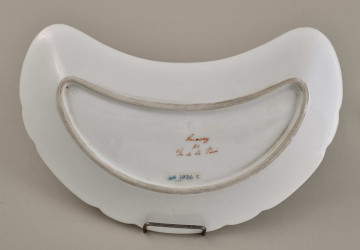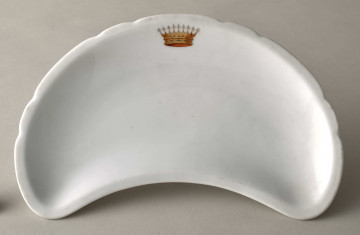
Chamber pot from the set with lemons
Castle Museum in Łańcut
Part of the collection: Bronze Age
The clay vessel was found during the excavation of the Lusatian cremation cemetery in 1937, where ten graves surrounded by stones were uncovered. The excavations were conducted by the archaeologist from Szczecin, Hans Jürgen Eggers.
The shallow bowl has a fish-like shape and is dated to the Late Bronze Age – the Early Iron Age (ca. 900–600/550 BC). This period is known for art development, which can be observed on ceramic objects: numerous pottery forms and decorations. The idea of decorating ceramic objects with bird figures – the most common artistic motif of the Lusatian culture – probably came from the southern Europe, from the areas inhabited by the population of the Hallstatt cultures. Other known objects with such decorations are: clay figures used as rattles, handles in the form of bird’s heads, birds painted on the vessel’s bottom, and ornitomorphic vessels. Bronze objects, such as cult carriages and fibulae, also were decorated with depictions of birds. In addition to the bird shape, vessels resembling other animals were made, as well as leg- or shoe-shaped censers/furnaces, spools/candleholders, and drinking horns.
Monika Witek
Author / creator
Dimensions
the entire object: height: 4 cm, width: 15.8 cm
Object type
vessel
Technique
manual modelling
Material
clay
Origin / acquisition method
legal transfer
Creation time / dating
Creation / finding place
Owner
National Museum in Szczecin
Identification number
Location / status

Castle Museum in Łańcut

2nd half of the 19th century
Castle Museum in Łańcut

2nd half of the 19th century
Castle Museum in Łańcut
DISCOVER this TOPIC
National Museum in Szczecin
DISCOVER this PATH
Educational path